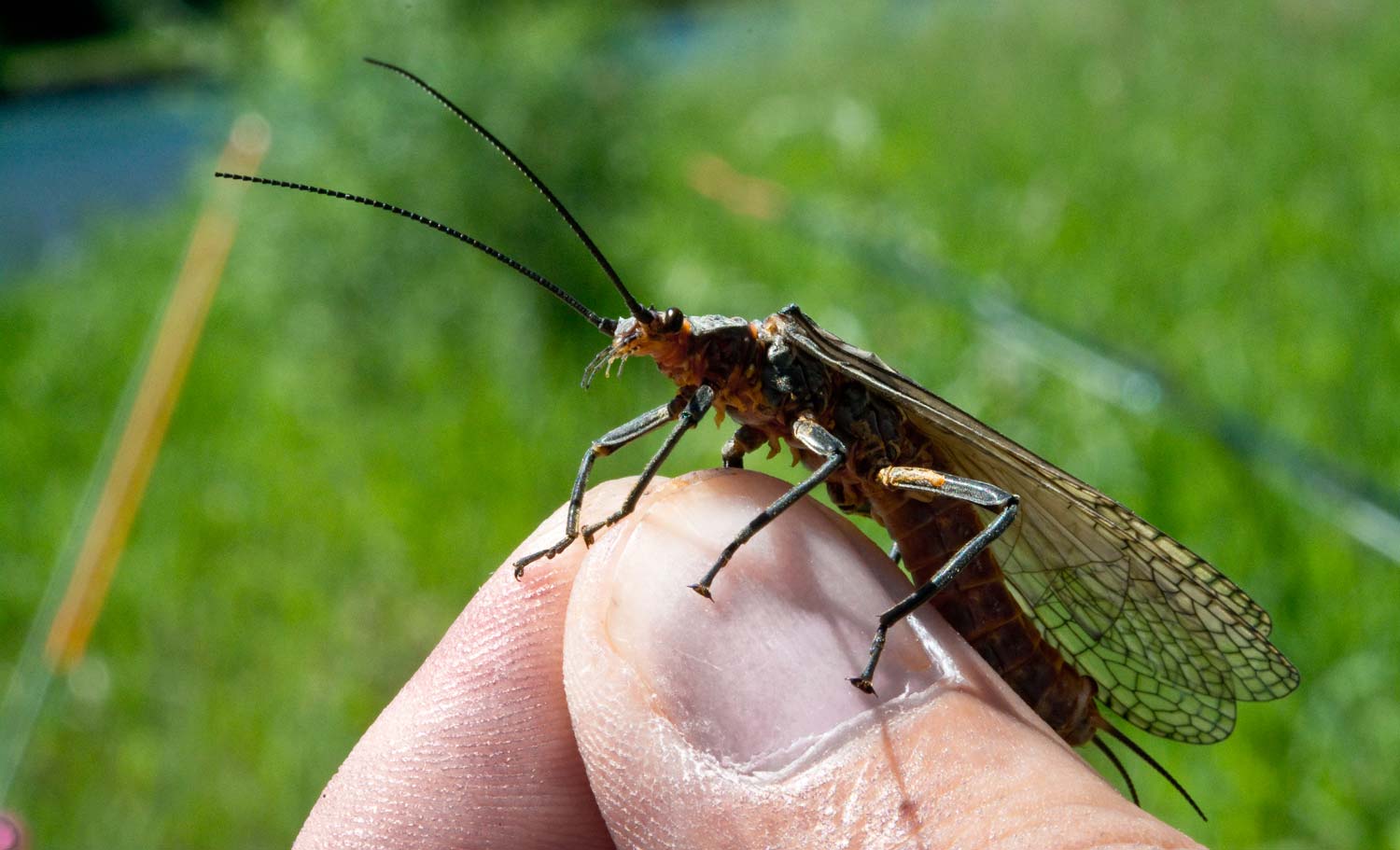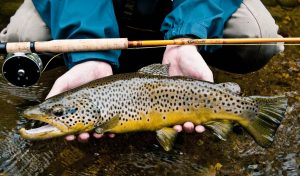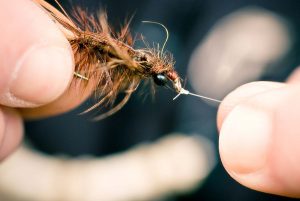
Photos by Louis Cahill
By Louis Cahill
I watched a video the other day about the most important insects for trout fishing.
The host listed the aquatic insects, we are all familiar with as anglers, in order of importance. I was a little shocked to hear my favorite bug come in last on the list, with very little discussion of his life cycle or how to imitate him.
I decided to take a few minutes to explain why the stonefly is my favorite pattern for trout.
If you are a dry fly purist, I can understand why you might not recognize the importance of the stonefly. The supersize varieties that come to mind are a brief, seasonal hatch and can be hard to predict for casual anglers. You might carry a few flies, in case you’re lucky enough see the huge bugs on the water, or you might drift one along the bank if nothing else is happening. If, however, you’re the kind of angler who likes fishing nymphs or, like me, you live somewhere nymph fishing is the starting point, not plan B, stoneflies are the bomb.
 There are many different varieties of stonefly and they come in all sizes. For trout feeding below the surface, which is most trout most of the time, they are an important food source, especially in the cooler months, and the patterns that imitate them offer some tactical advantages to anglers. Understanding these advantages means first knowing a little more about the life of a stonefly.
There are many different varieties of stonefly and they come in all sizes. For trout feeding below the surface, which is most trout most of the time, they are an important food source, especially in the cooler months, and the patterns that imitate them offer some tactical advantages to anglers. Understanding these advantages means first knowing a little more about the life of a stonefly.
Stoneflies are one of the oldest forms of life on the planet, predating the dinosaurs. They are a successful species but they still have some rough edges evolution hasn’t polished off. These evolutionary shortcomings are what makes them so interesting to fish and anglers.
• Stoneflies are slow to mature. Most varieties have a nymphal cycle lasting two to three years. Over that time they slowly grow from tiny nymphs to big, juicy monsters. That means two important things to anglers. In streams where they are found, stonefly nymphs are present all year round and examples of any species exist at many different sizes. That means a stonefly nymph is a good choice in any season and the selection of an appropriate size fly is pretty forgiving.
• Stoneflies are poor swimmers. The nymphs have hooks on they’re feet to hold on to rocky bottoms in fast water. Once they become dislodged, which happens often, they tumble pretty helplessly in the current. This makes them an easy meal for trout and easy to imitate for anglers.
•  Many stoneflies are big. That makes them an attractive food source for big trout. This is purely anecdotal, but most of the big trout I’ve caught in my life have eaten streamers or stoneflies. The size of the imitations also lends itself to building in weight, making the flies serve double duty as both weight and bait. This makes them especially useful in tandem with smaller nymphs. There is a school of thought that says lighter patterns move more naturally in the water. While I don’t disagree with that entirely, I think the practicality of getting the fly to the bottom is more important.
Many stoneflies are big. That makes them an attractive food source for big trout. This is purely anecdotal, but most of the big trout I’ve caught in my life have eaten streamers or stoneflies. The size of the imitations also lends itself to building in weight, making the flies serve double duty as both weight and bait. This makes them especially useful in tandem with smaller nymphs. There is a school of thought that says lighter patterns move more naturally in the water. While I don’t disagree with that entirely, I think the practicality of getting the fly to the bottom is more important.
• Stoneflies come in a wide variety of size and color, making fly selection easy. It’s pretty seldom that fish are selective when it comes to stonefly patterns. You can tie them as simple or as realistic as you like and they will still be effective. Beautiful woven patterns catch tons of fish and so do simple patterns like a Pat’s Rubber Legs, Wooly Bugger, or the Pickle. Many small nymphs effectively imitate stoneflies and mayfly nymphs at the same time. The Hairs ear is a great example.
•Stoneflies are prolific. That’s how they are a successful species, in spite of being such an easy meal. An adult female lays upwards of 6000 eggs at a time. Lots of eggs means lots of nymphs and lots of fish eating them.
OK, so where do I find these stoneflies and how do I fish them?
One of the stoneflies evolutionary shortcomings is that they need a lot of oxygen. This means that they thrive in cold, fast moving water that’s broken by lots of rocks, riffles, and falls. Classic mountain trout streams are almost always home to stoneflies. Anywhere there is pocket water, you’ll find stoneflies, making them a great choice for less experienced anglers. Read why here.
 I almost always fish a stonefly nymph as the point fly in tandem with a smaller nymph. In deep or fast water I will place a split shot above the knot attaching my tippet, then 12-16 inches below the weight a heavy stonefly imitation. I’ll then choose a dropper based on the conditions a foot or so below that. There are many effective ways to set this up. Whether you like to fish nymphs on a tight line, with a subtle indicator, or a huge bobber, tied on the tags of a surgeon’s knot or tied off the bend of the hook, the pattern will be just as effective as long as you get a good drift.
I almost always fish a stonefly nymph as the point fly in tandem with a smaller nymph. In deep or fast water I will place a split shot above the knot attaching my tippet, then 12-16 inches below the weight a heavy stonefly imitation. I’ll then choose a dropper based on the conditions a foot or so below that. There are many effective ways to set this up. Whether you like to fish nymphs on a tight line, with a subtle indicator, or a huge bobber, tied on the tags of a surgeon’s knot or tied off the bend of the hook, the pattern will be just as effective as long as you get a good drift.
If you’re not fishing stonefly nymphs, you’re missing out on some really productive trout fishing. I encourage you to give it a try. Especially in the colder months when the surface action is slow.
Here are a couple of videos to help you choose or tie effective stonefly patterns.
Louis Cahill Gink & Gasoline www.ginkandgasoline.com hookups@ginkandgasoline.com Sign Up For Our Weekly Newsletter!

Love the post on Stone flies and the videos. Keep up the good work.
Great article and very informative for a beginner such as my self.
Stoneflies are great. Besides being terrific fish catchers for fly fishing, they are great fun to watch when on the wing as adults.